How to Cut and Eat Dragon Fruit
This post may contain affiliate links. Please read the disclosure policy.
Learn how to cut dragon fruit quickly and easily with this step-by-step guide. The sweet flesh is delicious and packed full of nutrients. You can eat dragon fruit on its own as a simple and refreshing snack or add it to fruit salads, smoothies, desserts and more!
Dragon fruit can seem a bit intimidating at first with its unique look and bright colors. Learning how to prepare it is actually quite easy, and the more you eat it, the more you’ll love it!
This tropical fruit makes a delicious snack that’s slightly sweet with an interesting texture. It’s low in calories with only 60 calories per dragon fruit!
What is Dragon Fruit (Pitaya)?
Dragon fruit, also called pitaya or pitahaya, is a tropical fruit coming from the dragon fruit tree, which is actually a type of large cactus. There are three varieties of dragon fruit:
- Pink skin with white flesh (white dragon fruit)
- Pink skin with red flesh (red dragon fruit)
- Yellow skin with white flesh (yellow dragon fruit)
All of these varieties have tiny black seeds interspersed throughout the flesh and a very similar taste.
Most U.S. dragon fruit used to come from Latin America or Asia and is fairly expensive. However, as America’s fastest-growing exotic fruit, there’s now a domestic harvest of more than one million pounds in Florida alone!
Health Benefits of Dragon Fruit
Dragon fruit is loaded with nutrients and has many impressive health benefits including:
- Beneficial antioxidants like vitamin C.
- 7 grams of fiber per cup along with prebiotics for a healthy gut and digestive health.
- Plant compounds like polyphenols and carotenoids that help to strengthen the immune system.
- Beneficial minerals like iron and magnesium.
Some people have called it the next pomegranate in terms of super food properties!
What Does Dragon Fruit Taste Like?
Dragon fruit has a mild and slightly sweet taste, resembling a cross between kiwifruit, pear and sugar beets. The flesh has a slightly crunchy texture, like watermelon or starfruit but slightly softer. Dragon fruit has almost no smell.
Types of Dragon Fruits
There are three main types of dragon fruit based on appearance and flavor:
- Dragon Fruit with white flesh (Hylocereus undatus): This is the most common type of dragon fruit, with red or pink outer skin and white flesh inside. It is often referred to as the “white-fleshed” dragon fruit.
- Red Dragon Fruit (Pink Dragon Fruit): This type of dragon fruit has bright red outer skin and red flesh inside. It is often referred to as the “red-fleshed” dragon fruit.
- Yellow Dragon Fruit: This type of dragon fruit has a yellow outer skin and white flesh inside. It is often referred to as the “yellow-fleshed” dragon fruit or the “golden dragon fruit”.
There are also some varieties of dragon fruit that have a hybrid of these three types, resulting in unique colors and flavors.
How to Pick the Best Dragon Fruit
When ripe, dragon fruit has bright, evenly colored skin. A few spots are normal, but a lot of dark blotches or blemishes usually indicate it’s overripe.
The outer skin should feel firm with a slight give. However, mushy skin or wrinkles/sagging indicate it’s too old and should be discarded.
Dragon fruits are usually available year-round in Asian grocers and sporadically in other grocery stores. If you can’t find any, try ordering online (Amazon). Once you’ve selected the perfect dragon fruit, it’s time to cut it up.
Cutting Dragon Fruit
Cutting dragon fruit is very easy. Place it on a clean cutting board and cut straight through the middle using a large sharp knife:
Then grab a large table spoon and slide it in between the skin the flesh, like you might do with an avocado or kiwi. You should then be able to lift the flesh out of the skin, or alternatively just peel the skin off using your fingers:
Place the flesh on a cutting board flat-side down and trim off any pink residues, which can be bitter. You can cut up dragon fruit into quarters like an apple, slice it widthwise into semicircles, or chop it into cubes or chunks as you like:
Dragon fruit is best when freshly cut. If you’re not ready to cut right away, it can sit for a day or two at room temperature on the counter. Any longer and you should store it in a sealed ziptop bag in the fridge for up to one week.
Here is a video tutorial showing how to prepare dragon fruit:
How to Peel Dragon Fruit
First, wash the fruit thoroughly before peeling it to remove any dirt or debris on the skin. It’s best to cut off the top and bottom of the fruit so that it’s easy to peel. You can also cut them into quarters.
Cut a lengthwise shallow slit on the fruit’s skin, then use your fingers to gently pull apart the skin and peel it off the fruit.
Note: If the fruit is ripe, the skin should come off easily, but if the fruit is not ripe, you may need to use a spoon to scoop out the flesh from the skin.
How to Eat Dragon Fruit
Once you’ve figured out how to cut dragon fruit, you can explore many ways to eat it. The easiest way is straight out of the skin with a spoon as a snack. Note: the skin is not edible.
If you’ve already cut the fruit into chunks, you can place them back into the half-shell for an attractive serving presentation (kids love this one). Alternatively, just put into a serving bowl.
While dragon fruit is delicious on its own, it’s even better added to fruit salads, smoothies, and desserts. Drinks have also been trending since Starbucks launched the mango dragon fruit refresher. Finally, dragonfruit can be substituted for kiwi in many recipes and goes well with berries, mango, kiwi, pineapple and papaya.
If you’re not consuming cut dragon fruit right away, store it for up to 1 day in an airtight container in the refrigerator. (Tip: sprinkle lemon juice on top to help it stay fresh.) Otherwise, freeze for up to 3 months for use in smoothies only, since the texture isn’t the same for eating after freezing.
How to Tell If a Dragon Fruit Is Ripe
- Appearance: A ripe dragon fruit should have a bright pink color with smooth skin. The skin of a fresh dragon fruit should also be free of blemishes or dark spots. The stem of a ripe dragon fruit should be dry and slightly brown. If it is still green or moist, the fruit may not be ripe.
- Texture: The fruit should feel slightly soft to the touch, but not mushy or squishy. If the skin is too hard, the fruit may not be ripe yet.
- Smell: A ripe dragon fruit should have a sweet, slightly floral scent. If the fruit has no scent or a sour smell, it may not be ripe.
Dragon Fruit nutrition facts
Dragon fruit is a good source of dietary fiber, prebiotics, magnesium, iron, and potassium. It’s no surprise that it’s regarded as a superfruit, especially the red pulp variety. The colorful pigment delivers additional plant polyphenols, like the antioxidants vitamin C, betalains, lycopene, and beta-carotene to prevent cellular damage.
Dragon fruit is low in calories and high in nutrients. Here are the nutrition facts for one cup (227 grams) of dragon fruit:
- Calories: 136
- Protein: 3 grams
- Fat: 0 grams
- Carbohydrates: 29 grams
- Fiber: 7 grams
- Sugar: 13 grams
- Vitamin C: 9% of the Daily Value (DV)
- Iron: 8% of the DV
- Magnesium: 18% of the DV
- Potassium: 8% of the DV
It’s also a good source of antioxidants, including betacyanins, which give the fruit its bright pink color. These antioxidants help to protect your cells from damage caused by free radicals.
How to store dragon fruit
There are several ways to store dragon fruit depending on whether it’s ripe or not and whether you are ready to eat them. It’s important to store it properly to keep it fresh and prevent it from spoiling quickly.
- Store it at room temperature: It can be stored at room temperature for 2-3 days before it starts to ripen further. Make sure to keep it away from direct sunlight or heat.
- Store it in the fridge: If you’re not planning on eating the dragon fruit right away, store it in the refrigerator to extend its shelf life. Place the fruit in a sealed and it’ll last for up to 5-7 days.
- Freeze it for longer storage: Simply cut the fruit into small pieces, place them in a freezer-safe bag, and freeze for up to 6 months.
Side Effects
Dragon fruit is good for you in general. There are a few potential side effects as below:
- Blood sugar fluctuations: Dragon fruit is high in natural sugars, which can cause blood sugar levels to rise rapidly, especially in people with diabetes.
- Diarrhea: It is high in fiber, which can cause digestive discomfort and diarrhea in some people, especially if consumed in large quantities.
- Allergic reactions: Some people may be allergic to dragon fruit, which can cause symptoms such as itching, swelling, hives, and difficulty breathing.
- Abdominal pain: Eating large quantities of dragon fruit can cause stomach pain, bloating, and cramping.
Best Dragon Fruit Recipes
- Dragon Fruit Smoothie
- Pitaya Bowl
- Starbucks Mango Dragon Fruit Refresher
- Mango Dragon Fruit Lemonade Drink
- Pink Drink
FAQ
What’s the difference between pitaya and dragon fruit?
Pitaya and dragon fruit are actually two names for the same fruit. The fruit is native to Central and South America, and it is commonly grown in Southeast Asia, particularly in Vietnam, Thailand, and Malaysia.
How to cut a yellow dragon fruit?
You can cut a yellow dragon fruit the same way you cut a regular red dragon fruit. Make sure to choose a ripe dragon fruit that is bright yellow in color, and free of any soft spots or bruises. Wash the fruit thoroughly under running water and dry it with a clean towel. Then cut it following the same steps. Discard the skin or use it as a decorative bowl for serving the fruit.
Is dragon fruit good for you?
Yes, dragon fruit is a healthy fruit that is good for you. It’s low in calories and high in fiber, vitamin C, and antioxidants. The fiber in dragon fruit can help promote healthy digestion and reduce the risk of constipation. The antioxidants in dragon fruit can help protect the body from damage caused by free radicals, which can lead to chronic diseases such as cancer, heart disease, and Alzheimer’s disease.
Dragon fruit is also a good source of iron, which is important for maintaining healthy blood cells and preventing anemia. Additionally, the fruit contains several other essential vitamins and minerals, including vitamin B6, calcium, and magnesium.
Can you eat raw dragon fruit?
Yes, you can eat raw dragon fruit. In fact, it’s the most popular way to eat dragon fruit, either on its own or add it to smoothies, salads, and other dishes.
How many calories are in dragon fruit?
A 100-gram serving of dragon fruit contains approximately 60 calories. However, the exact number of calories in dragon fruit can vary depending on factors such as the ripeness of the fruit.
Where does dragon fruit grow?
It is native to Mexico and Central America, but it is now widely grown in many tropical and subtropical regions around the world, including Southeast Asia, South America, and parts of the Caribbean.
Can you eat dragon fruit’s seeds?
The seeds of the dragon fruit are small and black, and they are edible. They have a slightly crunchy texture and a mild, nutty flavor. Some people prefer to remove the seeds before eating dragon fruit, while others enjoy eating them along with the flesh of the fruit.
What is the dragon fruit season?
The main season for dragon fruit is from late spring to early fall, typically from May to November in the Northern Hemisphere. However, in some regions such as Southeast Asia, dragon fruit can be harvested throughout the year due to its year-round warm climate.
Can you freeze dragon fruit?
Yes, dragon fruit freezes relatively well. However, it is important to note that freezing may affect the texture and flavor of the fruit. To freeze dragon fruit, wash the fruit thoroughly and pat dry with a paper towel. Cut the flesh into small pieces. Then place them on a baking sheet lined with parchment paper. Freeze for about 1-2 hours or until the fruit is frozen solid. Transfer the frozen dragon fruit to an airtight container or freezer bag, and store it in the freezer.
Frozen dragon fruit can be stored in the freezer for up to 6 months. It can be used in smoothies, sorbets, and other recipes that call for frozen fruit.
More tropical fruits:
How to Cut Dragon Fruit
Ingredients
- 1 medium dragon fruit
Optional Additions
- 1 cup mango, chunks (1 medium mango)
- 1 cup pineapple, chunks (1/4 pineapple)
- 1 cup kiwi, chunks (2 medium kiwis)
- 2 teaspoons lemon juice, freshly squeezed
Instructions
How to Cut Dragon Fruit
- Place the dragon fruit on a clean cutting board.
- Using a sharp knife, cut each one in half lengthwise down the middle. The flesh may be white or red.
- Slide a large table spoon in between the skin and the flesh, sliding it along the peel to separate the flesh (like you might do for an avocado or kiwi).
- Scoop out the flesh onto the cutting board. Make sure to trim off any pink residues, which can be bitter. (Optional: Reserve the skin halves for serving.)
- Repeat the previous step for the remaining half.
- Place the flesh flat-side down and chop into cubes or chunks as desired. You can also slice it widthwise into semicircles.
Dragon Fruit Salad
- Cut the optional mango, pineapple, and kiwi into chunks.
- In a medium bowl, combine the cut dragon fruit with the mango, pineapple, and kiwi.
- Sprinkle lemon juice on top and toss to combine.
Notes
- 1 dragon fruit yields 2 cups of diced fruit.
- Serving size: 1 1/4 cup
- Nutrition information provided below includes the optional mango, pineapple, kiwi, and lemon juice.
- Cut dragon fruit can be stored in an airtight container in the fridge for up to one day or frozen for up to 3 months.
Please read our nutrition disclaimer.
Equipment for Cutting Dragon Fruit
Editor note: Originally published Mar 4, 2019 and updated Feb 3, 2020.
© TIPBUZZ. Images and text on this website are copyright protected. Please do not post or republish without permission. If you want to republish this recipe, please link back to this post. This post may contain affiliate links. Read the disclosure policy here.
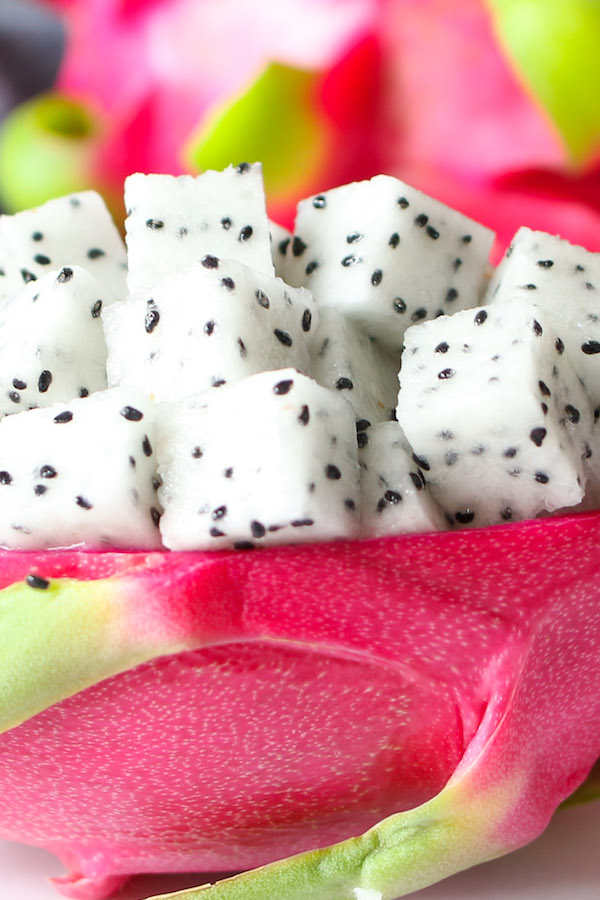
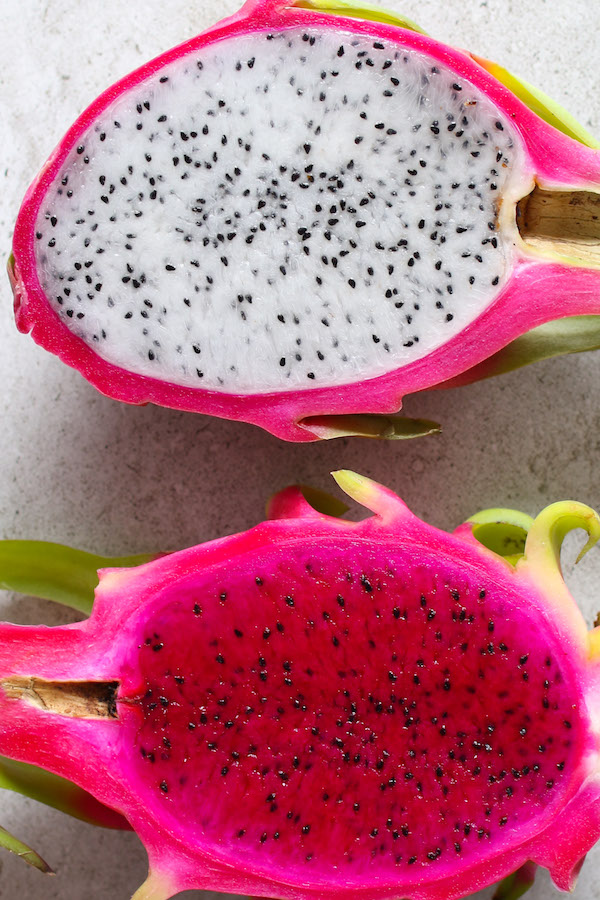
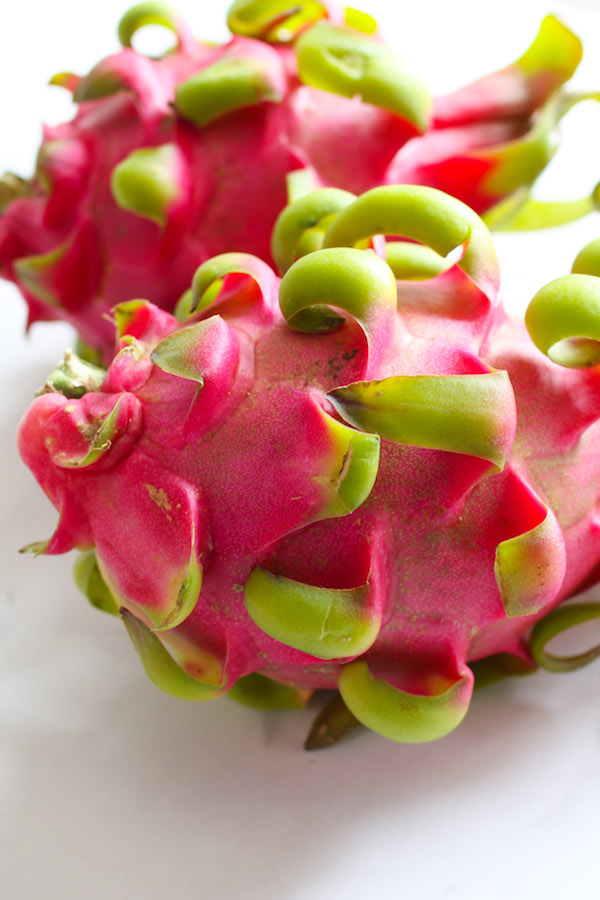
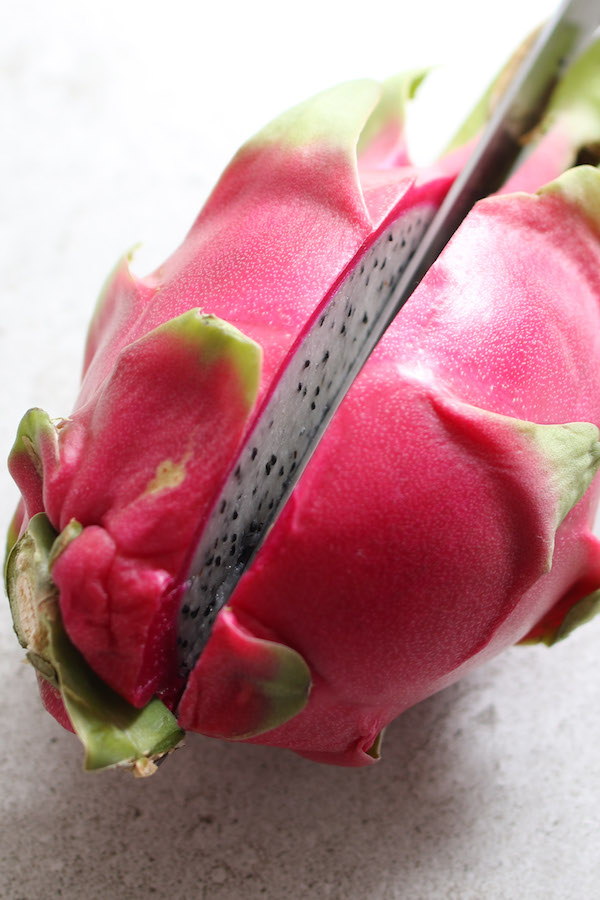
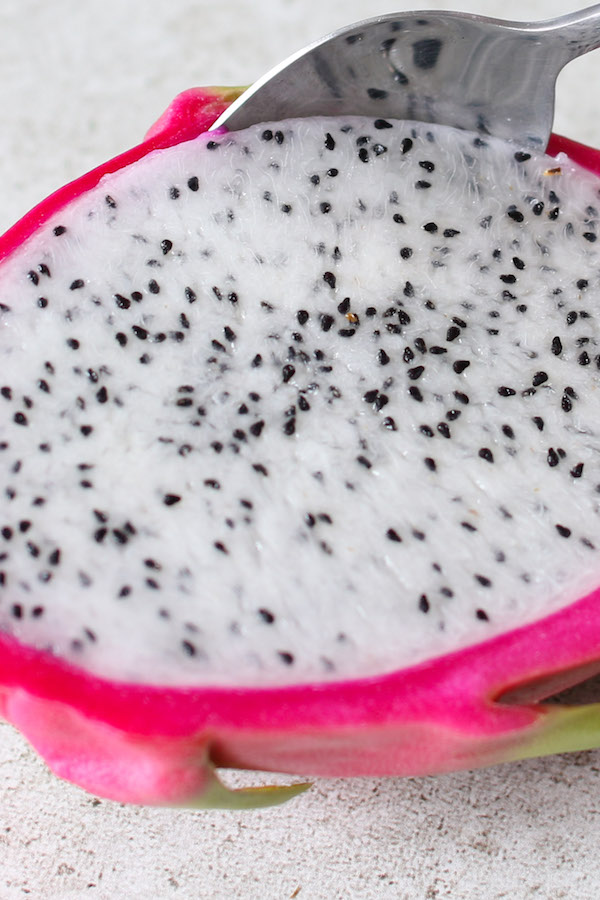
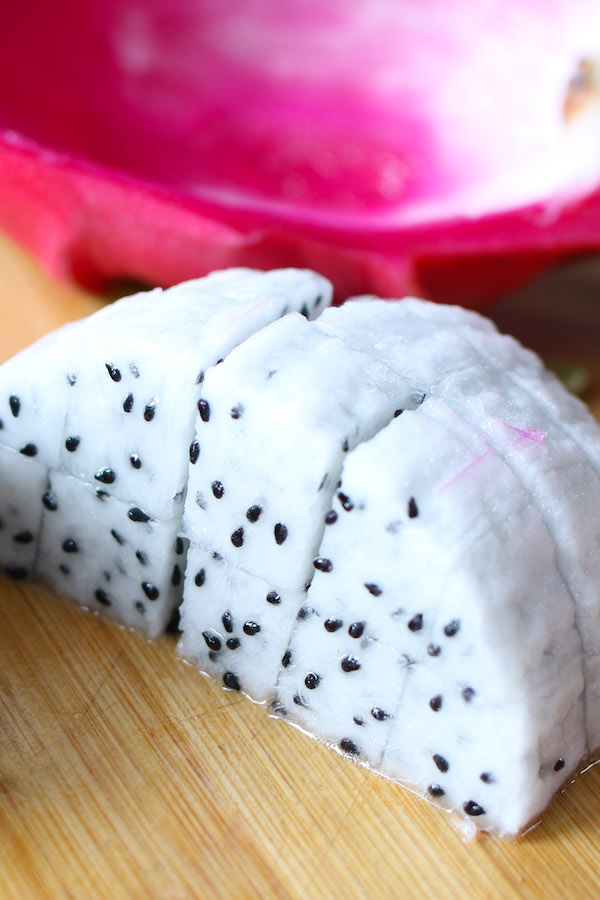
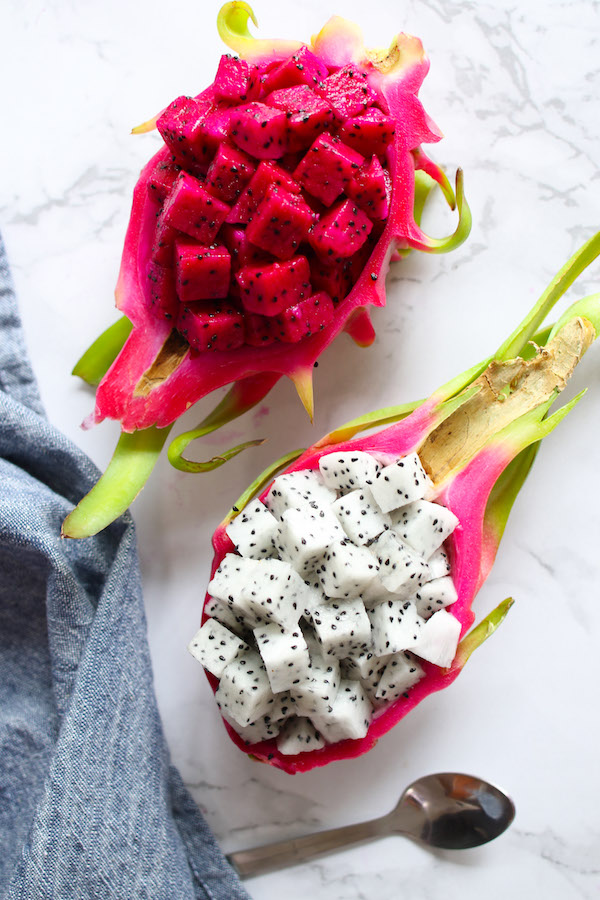
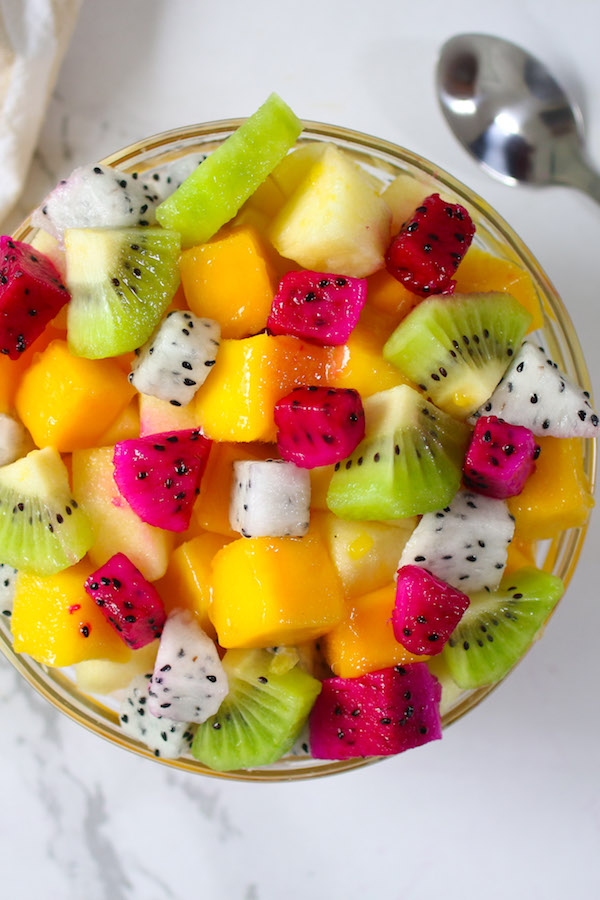
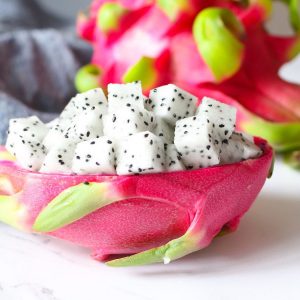
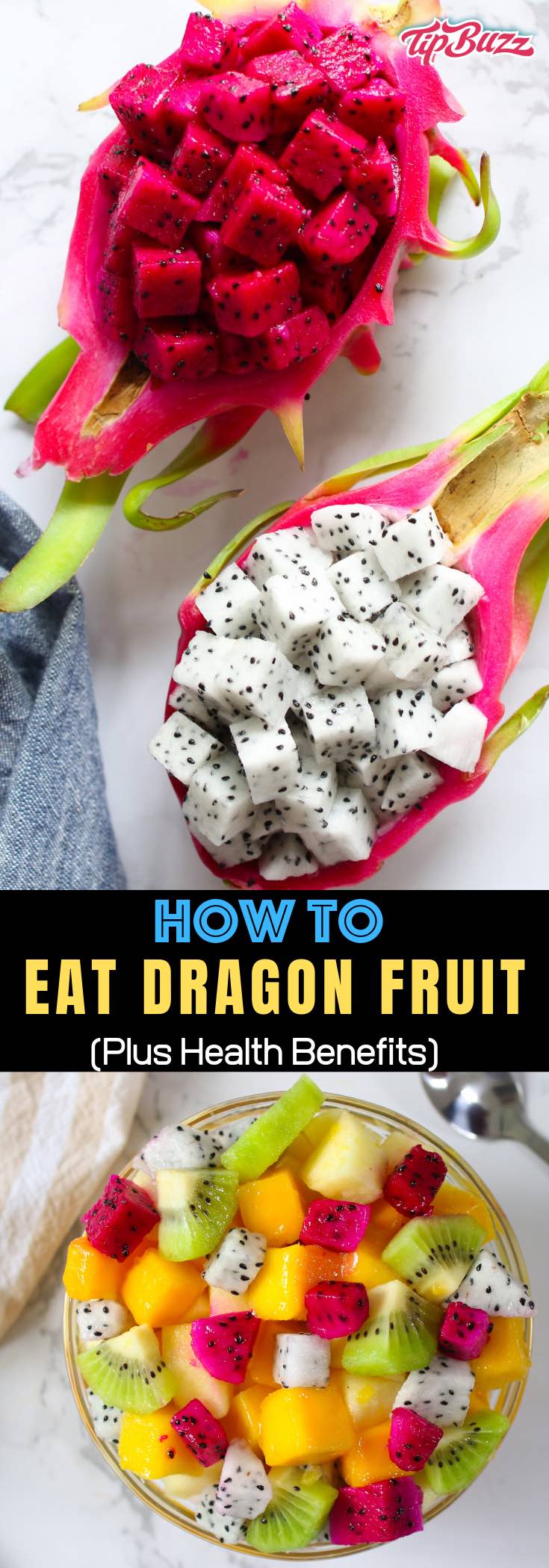







Learned this to be a very excellent fruit with many medicinal properties and minerals. And seeds with Omega 3 and6. So good for toothache pain days ; so soft to chew.
You could also cut it in 3and score and peeloff the peel.
Very informative
Hi Rathiin, Glad to hear and thanks for letting me know.
How can you tell which fruit is red or white inside
Hi Dorothy, Such a great question and the answer is: you can’t! They look identical on the outside. Ask your grocer and hopefully they will know. Hope that helps!
Chris
Dragon can we take during pregnancy?
Hi Deepak, Thanks for your comment. It’s best to check with a medical professional on these questions, but dragon fruit is generally considered safe. These are concerns with other fruits like papaya during pregnancy, however.
Very helpful for first time dragon fruit eaters, such as myself
Thanks so much Judy and happy New Year!
I Love This Fruit
Hi Vickie, Thanks for your comment and enjoy!
This is so helpful! I love the fun and flavor dragon fruit adds to dishes!
Hi Beth, So happy to hear that and enjoy!
A pregnant woman can eat dragon fruit
This is always a tricky fruit to know how to serve! Thank you for the great tips, will be putting these to use today!
Hi Noelle, Glad you found it helpful and thanks! 🙂